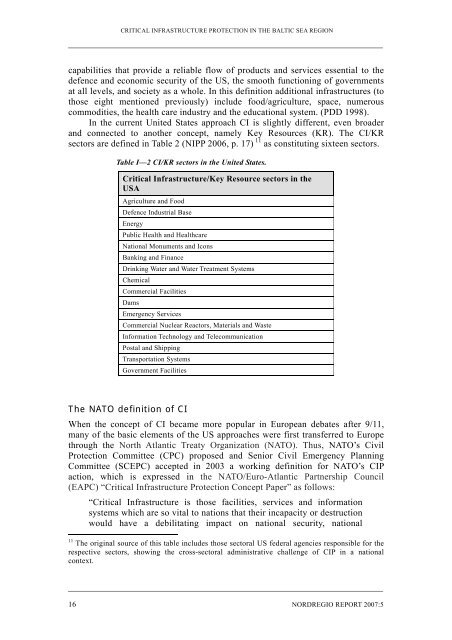Towards a Baltic Sea Region Strategy in Critical ... - Helsinki.fi
Towards a Baltic Sea Region Strategy in Critical ... - Helsinki.fi
Towards a Baltic Sea Region Strategy in Critical ... - Helsinki.fi
Create successful ePaper yourself
Turn your PDF publications into a flip-book with our unique Google optimized e-Paper software.
CRITICAL INFRASTRUCTURE PROTECTION IN THE BALTIC SEA REGION<br />
capabilities that provide a reliable flow of products and services essential to the<br />
defence and economic security of the US, the smooth function<strong>in</strong>g of governments<br />
at all levels, and society as a whole. In this def<strong>in</strong>ition additional <strong>in</strong>frastructures (to<br />
those eight mentioned previously) <strong>in</strong>clude food/agriculture, space, numerous<br />
commodities, the health care <strong>in</strong>dustry and the educational system. (PDD 1998).<br />
In the current United States approach CI is slightly different, even broader<br />
and connected to another concept, namely Key Resources (KR). The CI/KR<br />
sectors are def<strong>in</strong>ed <strong>in</strong> Table 2 (NIPP 2006, p. 17) 11 as constitut<strong>in</strong>g sixteen sectors.<br />
Table I—2 CI/KR sectors <strong>in</strong> the United States.<br />
<strong>Critical</strong> Infrastructure/Key Resource sectors <strong>in</strong> the<br />
USA<br />
Agriculture and Food<br />
Defence Industrial Base<br />
Energy<br />
Public Health and Healthcare<br />
National Monuments and Icons<br />
Bank<strong>in</strong>g and F<strong>in</strong>ance<br />
Dr<strong>in</strong>k<strong>in</strong>g Water and Water Treatment Systems<br />
Chemical<br />
Commercial Facilities<br />
Dams<br />
Emergency Services<br />
Commercial Nuclear Reactors, Materials and Waste<br />
Information Technology and Telecommunication<br />
Postal and Shipp<strong>in</strong>g<br />
Transportation Systems<br />
Government Facilities<br />
The NATO def<strong>in</strong>ition of CI<br />
When the concept of CI became more popular <strong>in</strong> European debates after 9/11,<br />
many of the basic elements of the US approaches were <strong>fi</strong>rst transferred to Europe<br />
through the North Atlantic Treaty Organization (NATO). Thus, NATO’s Civil<br />
Protection Committee (CPC) proposed and Senior Civil Emergency Plann<strong>in</strong>g<br />
Committee (SCEPC) accepted <strong>in</strong> 2003 a work<strong>in</strong>g def<strong>in</strong>ition for NATO’s CIP<br />
action, which is expressed <strong>in</strong> the NATO/Euro-Atlantic Partnership Council<br />
(EAPC) “<strong>Critical</strong> Infrastructure Protection Concept Paper” as follows:<br />
“<strong>Critical</strong> Infrastructure is those facilities, services and <strong>in</strong>formation<br />
systems which are so vital to nations that their <strong>in</strong>capacity or destruction<br />
would have a debilitat<strong>in</strong>g impact on national security, national<br />
11 The orig<strong>in</strong>al source of this table <strong>in</strong>cludes those sectoral US federal agencies responsible for the<br />
respective sectors, show<strong>in</strong>g the cross-sectoral adm<strong>in</strong>istrative challenge of CIP <strong>in</strong> a national<br />
context.<br />
16 NORDREGIO REPORT 2007:5

















